I can't post a lot of images on this forum. Please refer to my post on Overclock.net for more images of benchmarks. Just look for my name since I can't post links here. I will be updating more benchmarks as well so check back later for more benchmarks.PM me if you need the link to the benchmarks.
It was suggested to me that Intels best platform to date could be the X58-LGA1366. From the looks of it, that suggestion may have been correct. Moving into its sixth year in the market; the legacy X58\Tylersburg is still alive and kicking. There appears to be plenty of life in the platform now that high-end server microprocessors are more affordable. This review is mainly for those who are on the fence and thinking about upgrading to X79 or possibly the X99. I also understand that Haswell-E is right around the corner, but some users might not want to upgrade unless they absolutely have to. Some users cant always buy the latest and greatest. Personally I can, but only if I feel as if Im getting a lot more than what I already have.
To most X58 users Intels X79 felt like a side-grade instead of an upgrade. Im not saying X79 doesnt offer a lot, but is it worth the price at this point? The architectures are obviously different. However, the X58 now has upgrades that cost less than $250.00-$300.00 that can easily even up the playing field a bit. Hex-cores are available and more affordable now. Unlike Intel latest Xeons [Sandy & Ivy Xeons], which have locked straps, LGA1366 has the ability to overclock Xeons by increasing the BLCK and\or CPU ratio. Im sure many users are hoping to add as many years to the awesome X58 platform as possible. Many will tell others to upgrade, but not so fast. Ive taken the time to compare my Xeon X5660 and L5639 to Intels latest and greatest high end CPUs.
While I am speaking about the Xeon L5639 be sure to check my review here:
No editing mod edits or warning. No referencing you stuff as your site.
Markfw900
I am locking this thread due to numerous infractions of policy, including editing mod edits.
I cover the CPU benchmarks and gaming benchmarks. I also added something I like to call Real-Time Benchmarks which is for gaming. Instead of running a benchmark tool, I literally capture the frame times and frame rates from actual gameplay. I try to play at least 25 minutes or longer to give a good review. I also try to pick the most demanding levels. For an example, my i7-960 @ 4.2Ghz struggled to play Crysis 3 maxed @ 1080p. There was constant micro stutter. After I installed my L5639 and later the X5660, the game is much more playable and runs at a smoother rate. I show the actual data from my play through.
Moving on, I have made a brief chart comparing the X58 architecture to the X79 architecture.
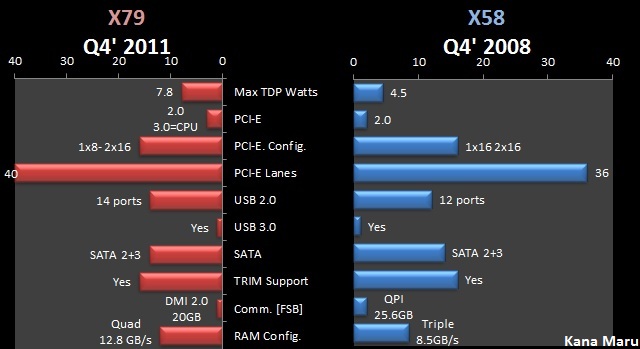
Now you can see why a lot of X58 users felt like this platform was a side grade. PCI-E 2.0 still has plenty of bandwidth for high end cards. There have been a lot of reviews that proves that there is a minor difference between PCI-E 2.0 and 3.0. X58 gamers can still enjoy high end gaming as usual. So hopefully my review will help X58 users that might want to make a minor upgrade to their existing system, rather than upgrade to a new build.
My PC Specs:
Motherboard: ASUS Sabertooth X58
CPU: Xeon X5660 @ 4.8Ghz
CPU Cooler: Antec Kuhler 620 Push/Pull
GPU: GTX 670 2-Way SLI
RAM: 12GB DDR3-1600Mhz [2x6]
HDD: x3 [no RAID] Seagate Barracuda 7,200rpm High Performance Drives
PSU: EVGA SuperNOVA G2 1300W 80+ GOLD
Monitor: Dual Res- 1080p, 1400p, 1600p
OS: Windows 7 64-bit
I had a decent SSD at one point that contained my OS. It died randomly one day and Im sticking with traditional HDDs from now on or at least for a few more years. HDDs move plenty of bandwidth IMO.
HDD Benchmark:

4.8Ghz

----
5Ghz
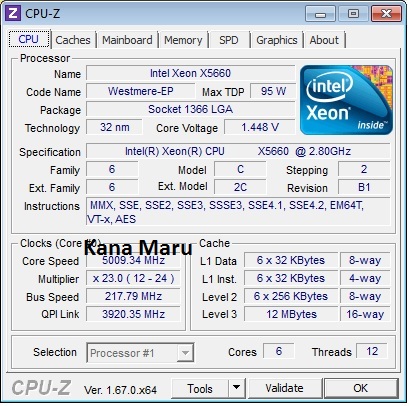
5Ghz takes a bit more vCore [1.5v], but I don't feel safe running 5Ghz a lot so I'll stick with 4.8Ghz
----------
I will admit that I was pretty excited when I first received my X5660. I only spent about $200 for it. I couldnt find a lot of info on it. Some of the info I found was true and the other info was wrong. Finding info on this chip was much easier than my Xeon L5639. The X5660 is rated at 6.4 GT/s and Ive personally pushed it all the way to 8 GT/s. It is a 32nm processor with 12MB a 95Watt Max TDP. Theres a lot of more info you can search and find. Now when I first installed the chip I was amazed at the low temps it maintained. The cores usually stayed below 23C in my room that was approx. 21C. Default voltages range from 0.88vCore to 1.18vCore [3.2Ghz-x24]. During 100% Loads the cores never went above 32c. Obviously I couldnt wait to overclock this CPU and Ill speak more on the overclocking below.
X5660 Stock clocks and minor BLCK overclock
I ran a few quick tests in Cinebench R11.5 after I first installed this chip. I scored a 7.71pts @ stock clocks 3.2Ghz [x24]. One of the impressive things about this chip is that the voltage was extremely low. The idle voltage was 0.88v and the highest voltage was 1.18v @ stock clocks. What was even more impressive was that HWiNFO 64 read 1.6Ghz as the idle speed. This could be an error, but HWiNFO is usually on the mark. So I performed a minor increase to the BLCK. I pushed it from 133 to 166. I only increased the BLCK and left everything else set to auto. I was able to hit 3980.50Mhz [x24] very easily or in other words 4Ghz. This only required 1.22vCore! This is only 0.04v above the highest default settings [1.18v] and I noticed the idle clock speed increased to 2Ghz [1990Mhz] in HWINFO 64.
Obviously the 4Ghz will down clock to 3.8Ghz after using more than two cores. @ 4Ghz [3.8Ghz -x23] I scored 9.64pts in Cinebench R11.5. Not too bad at all. At this speed the Xeon L5639 with a highly clocked BLCK @ 228 [and other settings] running @ 4.1Ghz is only 10% faster than the X5660 @ 4Ghz\3.8Ghz-BLCK 166. With a minor bump in BLCK and with ZERO other changes the X5660 was already looking better than my lovely L5639. If you were to compare my X5660 @ 4Ghz\3.8Ghz [x23] w/ BLCK 166-1600Mhz RAM to Intels i7-4960X @ stock clock, the difference in speed is only 14.8%. This is extremely minor if you are looking to upgrade from X58 to X79 and may not be worth it at this point if you dont plan to heavily overclock. This CPU definitely has plenty of headroom. Continue reading more for the Cinebench R11.5 overclocked settings below.
Taking another look at the Xeon L5639 vs Several Intel Stock clocks
As the title suggest, I'm comparing an overclocked L5639 @ 4.1Ghz to stock High-End Intel CPUs. The i7-4770K isn't "that" high-end, but I have seen people upgrading to Haswell. This should give LGA 1366-X58 users an ideal comparison to stock higher end CPUs. I personally like to compare my overclock CPU to Intels latest stock clocks. It really helps me decide if an upgrade is really worth it or not. Now does this mean the Xeon L5639 or Xeon X5660 would perform better clock for clock [?] of course not, due to the fact that the CPUs use different architectures to perform. Obviously people who still use their X58 as their main gaming and workstation platform will be looking to overclock the Xeon L5639 and the Xeon X5660. The highest constant overclock I could achieve with a reasonable vCore while using the Xeon L5639 was 4.1GHz. I've gathered several stock clock benchmarks from reputable review sites. So let's see how a overclocked Xeon L5639 compares to several CPUs.
Obviously the latest and greatest Intel CPUs will overclock better. They also cost over $1000.00. While the L5639 [$70-$150] and X5660 [$200-$300] are affordable now. So the cheaper L5639 does pack a nice punch for those who are still running the X58. If you can manage to reach a high BLCK with the L5639 youll see that the i7-4960X [stock] is only 4.2% faster than the overclocked L6539. The Xeon X5660 is unlocked which makes overclocking much easier. The Xeon L5639 is a locked CPU with a x20 multiplier. The multiplier fluctuates [L5639 [x20]+X5660 [x24]-Xeons] with the amount of active cores.
For instance, using the Xeon L5639 as a example: Cores 1 & 2 will operate at x20. Once the 3rd OR 4th core becomes active the multiplier will drop to x19. When Core 5 OR 6 is active it will drop the multiplier to [x18] and so on. x16 is the lowest multiplier. Some motherboards can lock the CPU multiplier\CPU Ratio to x16 or x18. The following x19 and x20 can only be enabled if you have the C-state functions. So the x18 CPU Ratio should be your main focus. The only way to overclock this CPU is to increase the Ratio and the BCLK and various settings in the BIOS. With all of this being said, the 1366-Xeon and i7 "X & K" counterparts can and will be unlocked; allowing a much easier overclock. Therefore the L5639 takes some patients to overclock past BLCK 200-215 due to the low multiplier. From what Ive read from several users; hitting 4Ghz is pretty easy for the average overclocker. I can easily tell you that the L5639 is pretty easy to overclock if you plan to use the C-States. Most X58 motherboards can move the BLCK upwards towards 200Mhz with minor issues. Which would put most around 3.8Ghz to 4.0Ghz with the x20 multiplier.
Overclocking the X5660 and Cinebench R11.5 results:
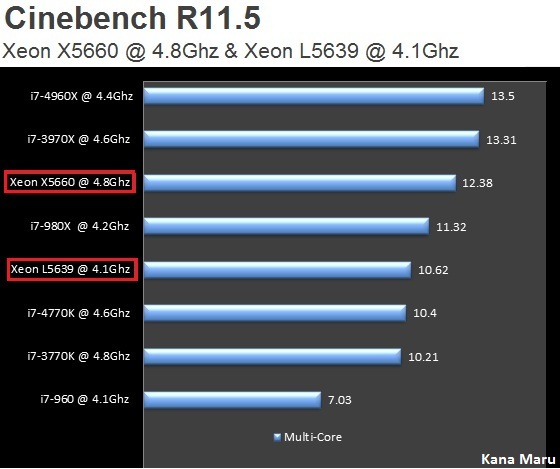
Before jumping right into the review about this benchmark section, I would like to point out my performance increase. Coming from the i7-960 I have seen a huge performance increase. The Bloomfields are pretty damn hard to OC past 4.2Ghz, mostly due to several limitations and voltage issues. Its hard to get the i7-960 past 4.1-4.2Ghz without some serious cooling and high vCore [or the golden chip]. My performance gains in CinebenchR11.5 were a breathtaking 76.1% if you compare my old i7-960@4.1Ghz to the X5660@4.8Ghz. Now thats what I call a upgrade.
X5660
The i7-4960X has a difference of 9% when compared to the X5660@4.8Ghz. Remember that Im only running DDR3-1600Mhz RAM. The Xeon X5660 is pretty impressive. At 1.36v I was able to hit 4.6Ghz. This voltage is right outside of Intels recommended max voltage of 1.35v. I was able to get a score of 11.89pts @4.6Ghz in Cinebench R11.5. This would put the i7-4960X @ 4.4Ghz only 13% higher than the X5660@4.6Ghz. When I pushed the BLCK to 209 and increased the vCore to a stable 1.43v, I was able to hit 4.8Ghz rather easily. This is outside of Intels max [only 0.08v], but safe enough for me to test and play games without worrying for hours. Youll definitely want aftermarket cooling if you plan to overclock this CPU heavily.
So once again the i7-4960X@4.4Ghz vs the X5660 @ 4.8Ghz difference is only 9%. Im only running DDR-1600Mhz RAM. So Im sure if you run faster RAM with tighter timings you can make the 9% even smaller, possibly 7% or less. I can say Im pretty impressed. Between the L5639@4.1Ghz vs the X5660@4.8Ghz, the different is roughly 17%; easily making the X5660 the better choice for X58 users who dont want to spend a lot on legacy technology.
L5639
Now let's even up the playing field a bit. I have included some overclocked examples to give you a better representation of the Locked L5639. The i7-4960X @ 4.4GHz is 27.1% faster than the L5639 @ 4.1Ghz while running DDR3-1333Mhz. 27.1% might not be enough to make a ton of X58 users to run out and spend approx. $1,059.00 for the latest and greatest CPU plus more for the latest platform MB. Most L5639 users should be able reach 4Ghz rather easily with the x20 multiplier and low vCore. For those who manage to reach 4Ghz or 4.1Ghz with the x18 multiplier; youll definitely get great results while playing games. Those who can reach 180Mhz-200Mhz [BLCK] will be just as happy. This CPU definitely gets the job done. Just be sure to leave the C-States enabled.
Cinebench R15:
i7-3970X @ 4.9Ghz = 1252 cb
Xeon X5660 @ 4.8Ghz = 1110 cb
Xeon L5639 @ 4.1Ghz = 965 cb
There are a lot of Cinebench R15 scores available. Cinebench loves faster RAM. I chose the i7-3970X that is ranked on HWBOT. The i7-3970X is 12.8% faster than my X5660. The i7-3970X is running DDR3-2423Mhz and once again Im running 1600Mhz with my X5660. Cinebench loves fast RAM so those numbers can easily change for both processors. Its hard finding units that match my RAM setting so I went with the processor speed.
The 3970X is roughly 30% faster than the L5639 running DDR3-1333Mhz. For only $70 [L5639] thats pretty damn good for nearly 6 year old technology. The i7-3970X processor retailed for $1,039.99 and currently $700-$900. The numbers look good, but the performance increase is what really matters to me. 12.8% [X5660] increase isnt going to make me run out and upgrade my PC. Youll have to also add the price of the new MB and CPU. Not to forget to mention coolers and other things needed when changing platforms\MBs. obviously enthusiast will always have that upgrade itch. Maybe the X5660 can ease the pain for a little longer.
Cinebench R10:
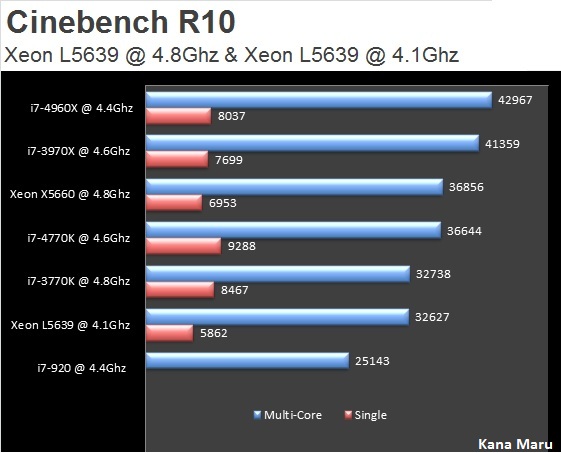
Xeon X5660 Performance Increase [+] \ Decrease [-]
Multi-Core - Overclocked:
i7-4960X @ 4.4Ghz = 42967 [-16.5%]
i7-3970X @ 4.6Ghz = 41359 [-12.2%]
X5660 @ 4.8Ghz = 36856 [0.0%]
i7-4770K @ 4.6Ghz = 36644 [+0.5%]
i7-3770K @ 4.8Ghz = 32738 [+12.5%]
L5639 @ 4.1Ghz = 32627 [+13%]
i7-920 @ 4.4Ghz = 25143 [+46.6%]
Singe Core - Overclocked
i7-4770K @ 4.6Ghz = 9288 [-33.5%]
i7-3770K @ 4.8Ghz = 8467 [-21.7%]
i7-4960X @ 4.4Ghz = 8037 [-15.5%]
i7-3970X @ 4.6Ghz = 7699 [-10.7%]
X5660 @ 4.8Ghz = 6953 [0.0%]
L5639 @ 4.1Ghz = 5862 [+18.6%]
Cinebench R10 is pretty old, but still useful. Well the Open GL isnt that useful for me, but the CPU benchmark scores are. In the Multi-core test the Xeon L5639 actually does pretty well. The i7-4960X is 31.7% faster than the Xeon L5639 @ 4.1GHz and 71% faster than the i7-920 @ 4.4Ghz. The i7-4770K [Quad-Core] clearly outperforms the other CPUs core for core in Cinebench R10 Single Core. The i7-4960X is only X5660 16.5% better in the Multi-Core benchmark. I7-920 and i7-960 users will definitely see a lot of performance gains.
WinRar v4.20:
Click here for the results:
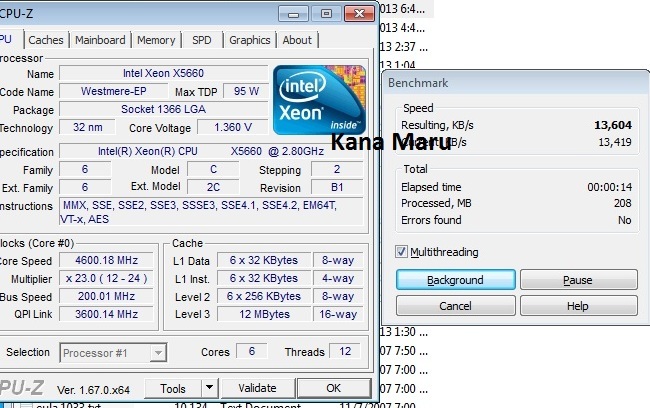
Moving on to the WinRar v4.20 benchmark, Im comparing the X5660, L5639, and the i7-960. The results were amazing if you consider my i7-960 results I only ran my X5660 @ 4.6Ghz during this test. Here is the breakdown:
Xeon X5660 @ 4.6Ghz = 13,604
Xeon L5639 @ 4.1Ghz = 12,441
i7-960 @ 4.2Ghz = 8,519
Users running the i7-920 or i7-960 will see a nice upgrade when it comes to extracting files. The L5639 performed very well for a chip that sells for $75-$150, especially if you are looking to upgrade your Quad-core on the X58 platform. Upgrading from my i7-960 to the X5660 gave me a 60% performance increase in WinRar v4.20 benchmark for approx. $200. The upgrade was worth the purchase so far. WinRar isnt the best benchmarking tool for multi-cores and relies heavily on tighter RAM timings. I can unpack 1.17GB with the X5660 in less than 10 secs. Ive also ran 7-zip benchmark as well. Check below.
7-zip v9.20:
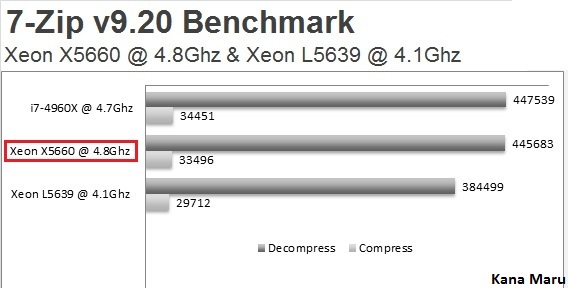
7-zip shows some interesting results. The Decompressing performance difference is less that 1% between the i7-4960X@4.7Ghz and the X5660@4.8Ghz. The exact number is 0.4%. When it comes to the compressing benchmark, the difference is only 2.85%. I expected a wider gap, but that wasnt the case here. The i7-4960X is 16.3% faster than the L5639.
AIDA64:
Ive ran a few of AIDA64 CPU benchmark test. The CPU Queen was the first test I ran. The Performance % is solely for the X5660.
CPU Queen:
X5660 Score Performance % Increase[+] \ Decrease [-]
i7-4960X @ 4.7Ghz = 81760 [-7.8%]
I7-3960X @ 4.7Ghz = 81402 [-7.3%]
X5660 @ 4.8Ghz = 75826 [0.0%]
L5639 @ 4.1Ghz = 64727 [+17.1%]
i7-4770K @ 4.6Ghz = 59950 [+26.5%]
i7-3770K @ 4.6Ghz = 59385 [+27.7%]
As we can see the X5660 is only 7% and roughly 2% behind the i7-3960X and the 4960X respectfully. The 3960X is roughly 26% faster than the L5639. This isnt that bad since I only paid $75 for my L5639. My X5660 is definitely staying in my system. Its continuing to put up great numbers.
Here are a few of my other AIDA64 benchmarks. I have included the L5636 as well. Feel free to compare your scores if you are using AIDA64 [Note: comparing newer versions of AIDA64 wont give accurate comparisons.]
X5660 Score Performance % Increase[+] \ Decrease [-]
CPU PhotoWorxx:
i7-4960X @ 4.7Ghz = 24876 MPixel/s [-45.1%]
X5660 @ 4.8Ghz = 17142 MPixel/s [0.0%]
L5639 @ 4.1Ghz = 15218 MPixel/s [+12.6%]
CPU ZLib:
i7-4960X @ 4.7Ghz = 598.8 [-23.6%]
X5660 @ 4.8Ghz = 484.3 [0.0%]
FPU VP8:
i7-4960X @ 4.7Ghz = 8392 [-23%]
X5660 @ 4.8Ghz = 6814 [0.0%]
L5639 @ 4.1Ghz = 5897 [+15.5%]
FPU SinJulia:
X5660 @ 4.8Ghz = 9955 [0.0%]
i7-4960X @ 4.7Ghz = 9483 [4.9%]
L5639 @ 4.1Ghz = 8506 [17%]
The X5660 holds its own in a lot of the test. The i7-4960X is king since its using newer technology. The X5660 actually beat the 4960X in one of the test by 4.9%. Thats pretty rare considering the architecture both processors are using. Overall I cant complain. Ill run more test when I get more time to run them. This should be enough in the meantime.
Performance Test 7
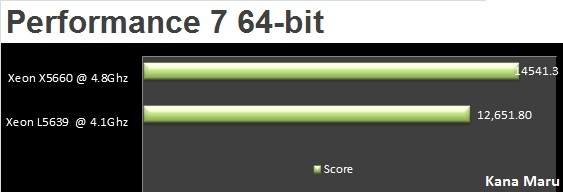
I could not find enough results to compare with Performance Test 7. Therefore I simply compared the X5660 to the L5639. This could give those looking to upgrade a decent comparison. Check below for the latest Performance Test 8 results.
Performance Test 8
Let's take a look at Performance 8. In this benchmark I compared the X5660 and L5639 with several baselines from similar clock speeds. I tried to get the best results with systems that are similar to one another.
Xeon 5660
At the time of this posting Performance Test 8 is not working properly. I have tried to reinstall the program, but I cannot resolve the issue. Therefore I cannot compare my X5660 @ 4.8Ghz with other processors running near the same speed and using the same memory speed. However, you can visit Performance Test web-site to compare my score to other scores. The website states that the graphs are updated once per day when there are at least 2 samples available.
Visit this web-site: No links to other websites for self promotion allowed
Markfw900
X5660 @ 4.8Ghz DDR3-1600Mhz CPU Mark: 12937
If I can find some CPUs with similar setups I will compare them and update this section of the review.
L5639 @ 4.1Ghz
Intel latest platforms have advantages over X58. The architecture is definitely different and quicker. However, that doesn't mean that the L5639 can't compete. You just can't expect the L5639 to win in every category. In this case it would be up to the user to decide. Upgrading from a i7-920 @ 4.2Ghz to a L5639 would be worth it, but would it be worth a X79+i7 upgrade? Judging from Performance 8 CPU Mark I personally wouldn't upgrade just yet.....well unless you are running a i7-920 or i7-960.
L5639 CPU Mark: Score
Performance Increase [+] \ Decrease [-]
--- Intel Core i7-4960X @ 4.2Ghz = 14853 [-34.4%]
--- Intel Core i7-3970X @ 4.0GHz = 13117 [-18.7%]
--- Intel Core i7-3770K @ 4.4GHz = 11786 [-6.6%]
--- Intel Core i7-4770K @ 4.2GHz = 11405 [-3.2%]
--> Intel Xeon L5639 @ 4.1Ghz = 11050 <-[0.0%]
--- Intel Core i7-920 @ 4.2Ghz = 7962 [+38.8%]
It was suggested to me that Intels best platform to date could be the X58-LGA1366. From the looks of it, that suggestion may have been correct. Moving into its sixth year in the market; the legacy X58\Tylersburg is still alive and kicking. There appears to be plenty of life in the platform now that high-end server microprocessors are more affordable. This review is mainly for those who are on the fence and thinking about upgrading to X79 or possibly the X99. I also understand that Haswell-E is right around the corner, but some users might not want to upgrade unless they absolutely have to. Some users cant always buy the latest and greatest. Personally I can, but only if I feel as if Im getting a lot more than what I already have.
To most X58 users Intels X79 felt like a side-grade instead of an upgrade. Im not saying X79 doesnt offer a lot, but is it worth the price at this point? The architectures are obviously different. However, the X58 now has upgrades that cost less than $250.00-$300.00 that can easily even up the playing field a bit. Hex-cores are available and more affordable now. Unlike Intel latest Xeons [Sandy & Ivy Xeons], which have locked straps, LGA1366 has the ability to overclock Xeons by increasing the BLCK and\or CPU ratio. Im sure many users are hoping to add as many years to the awesome X58 platform as possible. Many will tell others to upgrade, but not so fast. Ive taken the time to compare my Xeon X5660 and L5639 to Intels latest and greatest high end CPUs.
While I am speaking about the Xeon L5639 be sure to check my review here:
No editing mod edits or warning. No referencing you stuff as your site.
Markfw900
I am locking this thread due to numerous infractions of policy, including editing mod edits.
I cover the CPU benchmarks and gaming benchmarks. I also added something I like to call Real-Time Benchmarks which is for gaming. Instead of running a benchmark tool, I literally capture the frame times and frame rates from actual gameplay. I try to play at least 25 minutes or longer to give a good review. I also try to pick the most demanding levels. For an example, my i7-960 @ 4.2Ghz struggled to play Crysis 3 maxed @ 1080p. There was constant micro stutter. After I installed my L5639 and later the X5660, the game is much more playable and runs at a smoother rate. I show the actual data from my play through.
Moving on, I have made a brief chart comparing the X58 architecture to the X79 architecture.
Now you can see why a lot of X58 users felt like this platform was a side grade. PCI-E 2.0 still has plenty of bandwidth for high end cards. There have been a lot of reviews that proves that there is a minor difference between PCI-E 2.0 and 3.0. X58 gamers can still enjoy high end gaming as usual. So hopefully my review will help X58 users that might want to make a minor upgrade to their existing system, rather than upgrade to a new build.
My PC Specs:
Motherboard: ASUS Sabertooth X58
CPU: Xeon X5660 @ 4.8Ghz
CPU Cooler: Antec Kuhler 620 Push/Pull
GPU: GTX 670 2-Way SLI
RAM: 12GB DDR3-1600Mhz [2x6]
HDD: x3 [no RAID] Seagate Barracuda 7,200rpm High Performance Drives
PSU: EVGA SuperNOVA G2 1300W 80+ GOLD
Monitor: Dual Res- 1080p, 1400p, 1600p
OS: Windows 7 64-bit
I had a decent SSD at one point that contained my OS. It died randomly one day and Im sticking with traditional HDDs from now on or at least for a few more years. HDDs move plenty of bandwidth IMO.
HDD Benchmark:
4.8Ghz
----
5Ghz
5Ghz takes a bit more vCore [1.5v], but I don't feel safe running 5Ghz a lot so I'll stick with 4.8Ghz
----------
I will admit that I was pretty excited when I first received my X5660. I only spent about $200 for it. I couldnt find a lot of info on it. Some of the info I found was true and the other info was wrong. Finding info on this chip was much easier than my Xeon L5639. The X5660 is rated at 6.4 GT/s and Ive personally pushed it all the way to 8 GT/s. It is a 32nm processor with 12MB a 95Watt Max TDP. Theres a lot of more info you can search and find. Now when I first installed the chip I was amazed at the low temps it maintained. The cores usually stayed below 23C in my room that was approx. 21C. Default voltages range from 0.88vCore to 1.18vCore [3.2Ghz-x24]. During 100% Loads the cores never went above 32c. Obviously I couldnt wait to overclock this CPU and Ill speak more on the overclocking below.
X5660 Stock clocks and minor BLCK overclock
I ran a few quick tests in Cinebench R11.5 after I first installed this chip. I scored a 7.71pts @ stock clocks 3.2Ghz [x24]. One of the impressive things about this chip is that the voltage was extremely low. The idle voltage was 0.88v and the highest voltage was 1.18v @ stock clocks. What was even more impressive was that HWiNFO 64 read 1.6Ghz as the idle speed. This could be an error, but HWiNFO is usually on the mark. So I performed a minor increase to the BLCK. I pushed it from 133 to 166. I only increased the BLCK and left everything else set to auto. I was able to hit 3980.50Mhz [x24] very easily or in other words 4Ghz. This only required 1.22vCore! This is only 0.04v above the highest default settings [1.18v] and I noticed the idle clock speed increased to 2Ghz [1990Mhz] in HWINFO 64.
Obviously the 4Ghz will down clock to 3.8Ghz after using more than two cores. @ 4Ghz [3.8Ghz -x23] I scored 9.64pts in Cinebench R11.5. Not too bad at all. At this speed the Xeon L5639 with a highly clocked BLCK @ 228 [and other settings] running @ 4.1Ghz is only 10% faster than the X5660 @ 4Ghz\3.8Ghz-BLCK 166. With a minor bump in BLCK and with ZERO other changes the X5660 was already looking better than my lovely L5639. If you were to compare my X5660 @ 4Ghz\3.8Ghz [x23] w/ BLCK 166-1600Mhz RAM to Intels i7-4960X @ stock clock, the difference in speed is only 14.8%. This is extremely minor if you are looking to upgrade from X58 to X79 and may not be worth it at this point if you dont plan to heavily overclock. This CPU definitely has plenty of headroom. Continue reading more for the Cinebench R11.5 overclocked settings below.
Taking another look at the Xeon L5639 vs Several Intel Stock clocks
As the title suggest, I'm comparing an overclocked L5639 @ 4.1Ghz to stock High-End Intel CPUs. The i7-4770K isn't "that" high-end, but I have seen people upgrading to Haswell. This should give LGA 1366-X58 users an ideal comparison to stock higher end CPUs. I personally like to compare my overclock CPU to Intels latest stock clocks. It really helps me decide if an upgrade is really worth it or not. Now does this mean the Xeon L5639 or Xeon X5660 would perform better clock for clock [?] of course not, due to the fact that the CPUs use different architectures to perform. Obviously people who still use their X58 as their main gaming and workstation platform will be looking to overclock the Xeon L5639 and the Xeon X5660. The highest constant overclock I could achieve with a reasonable vCore while using the Xeon L5639 was 4.1GHz. I've gathered several stock clock benchmarks from reputable review sites. So let's see how a overclocked Xeon L5639 compares to several CPUs.
Obviously the latest and greatest Intel CPUs will overclock better. They also cost over $1000.00. While the L5639 [$70-$150] and X5660 [$200-$300] are affordable now. So the cheaper L5639 does pack a nice punch for those who are still running the X58. If you can manage to reach a high BLCK with the L5639 youll see that the i7-4960X [stock] is only 4.2% faster than the overclocked L6539. The Xeon X5660 is unlocked which makes overclocking much easier. The Xeon L5639 is a locked CPU with a x20 multiplier. The multiplier fluctuates [L5639 [x20]+X5660 [x24]-Xeons] with the amount of active cores.
For instance, using the Xeon L5639 as a example: Cores 1 & 2 will operate at x20. Once the 3rd OR 4th core becomes active the multiplier will drop to x19. When Core 5 OR 6 is active it will drop the multiplier to [x18] and so on. x16 is the lowest multiplier. Some motherboards can lock the CPU multiplier\CPU Ratio to x16 or x18. The following x19 and x20 can only be enabled if you have the C-state functions. So the x18 CPU Ratio should be your main focus. The only way to overclock this CPU is to increase the Ratio and the BCLK and various settings in the BIOS. With all of this being said, the 1366-Xeon and i7 "X & K" counterparts can and will be unlocked; allowing a much easier overclock. Therefore the L5639 takes some patients to overclock past BLCK 200-215 due to the low multiplier. From what Ive read from several users; hitting 4Ghz is pretty easy for the average overclocker. I can easily tell you that the L5639 is pretty easy to overclock if you plan to use the C-States. Most X58 motherboards can move the BLCK upwards towards 200Mhz with minor issues. Which would put most around 3.8Ghz to 4.0Ghz with the x20 multiplier.
Overclocking the X5660 and Cinebench R11.5 results:
Before jumping right into the review about this benchmark section, I would like to point out my performance increase. Coming from the i7-960 I have seen a huge performance increase. The Bloomfields are pretty damn hard to OC past 4.2Ghz, mostly due to several limitations and voltage issues. Its hard to get the i7-960 past 4.1-4.2Ghz without some serious cooling and high vCore [or the golden chip]. My performance gains in CinebenchR11.5 were a breathtaking 76.1% if you compare my old i7-960@4.1Ghz to the X5660@4.8Ghz. Now thats what I call a upgrade.
X5660
The i7-4960X has a difference of 9% when compared to the X5660@4.8Ghz. Remember that Im only running DDR3-1600Mhz RAM. The Xeon X5660 is pretty impressive. At 1.36v I was able to hit 4.6Ghz. This voltage is right outside of Intels recommended max voltage of 1.35v. I was able to get a score of 11.89pts @4.6Ghz in Cinebench R11.5. This would put the i7-4960X @ 4.4Ghz only 13% higher than the X5660@4.6Ghz. When I pushed the BLCK to 209 and increased the vCore to a stable 1.43v, I was able to hit 4.8Ghz rather easily. This is outside of Intels max [only 0.08v], but safe enough for me to test and play games without worrying for hours. Youll definitely want aftermarket cooling if you plan to overclock this CPU heavily.
So once again the i7-4960X@4.4Ghz vs the X5660 @ 4.8Ghz difference is only 9%. Im only running DDR-1600Mhz RAM. So Im sure if you run faster RAM with tighter timings you can make the 9% even smaller, possibly 7% or less. I can say Im pretty impressed. Between the L5639@4.1Ghz vs the X5660@4.8Ghz, the different is roughly 17%; easily making the X5660 the better choice for X58 users who dont want to spend a lot on legacy technology.
L5639
Now let's even up the playing field a bit. I have included some overclocked examples to give you a better representation of the Locked L5639. The i7-4960X @ 4.4GHz is 27.1% faster than the L5639 @ 4.1Ghz while running DDR3-1333Mhz. 27.1% might not be enough to make a ton of X58 users to run out and spend approx. $1,059.00 for the latest and greatest CPU plus more for the latest platform MB. Most L5639 users should be able reach 4Ghz rather easily with the x20 multiplier and low vCore. For those who manage to reach 4Ghz or 4.1Ghz with the x18 multiplier; youll definitely get great results while playing games. Those who can reach 180Mhz-200Mhz [BLCK] will be just as happy. This CPU definitely gets the job done. Just be sure to leave the C-States enabled.
Cinebench R15:
i7-3970X @ 4.9Ghz = 1252 cb
Xeon X5660 @ 4.8Ghz = 1110 cb
Xeon L5639 @ 4.1Ghz = 965 cb
There are a lot of Cinebench R15 scores available. Cinebench loves faster RAM. I chose the i7-3970X that is ranked on HWBOT. The i7-3970X is 12.8% faster than my X5660. The i7-3970X is running DDR3-2423Mhz and once again Im running 1600Mhz with my X5660. Cinebench loves fast RAM so those numbers can easily change for both processors. Its hard finding units that match my RAM setting so I went with the processor speed.
The 3970X is roughly 30% faster than the L5639 running DDR3-1333Mhz. For only $70 [L5639] thats pretty damn good for nearly 6 year old technology. The i7-3970X processor retailed for $1,039.99 and currently $700-$900. The numbers look good, but the performance increase is what really matters to me. 12.8% [X5660] increase isnt going to make me run out and upgrade my PC. Youll have to also add the price of the new MB and CPU. Not to forget to mention coolers and other things needed when changing platforms\MBs. obviously enthusiast will always have that upgrade itch. Maybe the X5660 can ease the pain for a little longer.
Cinebench R10:
Xeon X5660 Performance Increase [+] \ Decrease [-]
Multi-Core - Overclocked:
i7-4960X @ 4.4Ghz = 42967 [-16.5%]
i7-3970X @ 4.6Ghz = 41359 [-12.2%]
X5660 @ 4.8Ghz = 36856 [0.0%]
i7-4770K @ 4.6Ghz = 36644 [+0.5%]
i7-3770K @ 4.8Ghz = 32738 [+12.5%]
L5639 @ 4.1Ghz = 32627 [+13%]
i7-920 @ 4.4Ghz = 25143 [+46.6%]
Singe Core - Overclocked
i7-4770K @ 4.6Ghz = 9288 [-33.5%]
i7-3770K @ 4.8Ghz = 8467 [-21.7%]
i7-4960X @ 4.4Ghz = 8037 [-15.5%]
i7-3970X @ 4.6Ghz = 7699 [-10.7%]
X5660 @ 4.8Ghz = 6953 [0.0%]
L5639 @ 4.1Ghz = 5862 [+18.6%]
Cinebench R10 is pretty old, but still useful. Well the Open GL isnt that useful for me, but the CPU benchmark scores are. In the Multi-core test the Xeon L5639 actually does pretty well. The i7-4960X is 31.7% faster than the Xeon L5639 @ 4.1GHz and 71% faster than the i7-920 @ 4.4Ghz. The i7-4770K [Quad-Core] clearly outperforms the other CPUs core for core in Cinebench R10 Single Core. The i7-4960X is only X5660 16.5% better in the Multi-Core benchmark. I7-920 and i7-960 users will definitely see a lot of performance gains.
WinRar v4.20:
Click here for the results:
Moving on to the WinRar v4.20 benchmark, Im comparing the X5660, L5639, and the i7-960. The results were amazing if you consider my i7-960 results I only ran my X5660 @ 4.6Ghz during this test. Here is the breakdown:
Xeon X5660 @ 4.6Ghz = 13,604
Xeon L5639 @ 4.1Ghz = 12,441
i7-960 @ 4.2Ghz = 8,519
Users running the i7-920 or i7-960 will see a nice upgrade when it comes to extracting files. The L5639 performed very well for a chip that sells for $75-$150, especially if you are looking to upgrade your Quad-core on the X58 platform. Upgrading from my i7-960 to the X5660 gave me a 60% performance increase in WinRar v4.20 benchmark for approx. $200. The upgrade was worth the purchase so far. WinRar isnt the best benchmarking tool for multi-cores and relies heavily on tighter RAM timings. I can unpack 1.17GB with the X5660 in less than 10 secs. Ive also ran 7-zip benchmark as well. Check below.
7-zip v9.20:
7-zip shows some interesting results. The Decompressing performance difference is less that 1% between the i7-4960X@4.7Ghz and the X5660@4.8Ghz. The exact number is 0.4%. When it comes to the compressing benchmark, the difference is only 2.85%. I expected a wider gap, but that wasnt the case here. The i7-4960X is 16.3% faster than the L5639.
AIDA64:
Ive ran a few of AIDA64 CPU benchmark test. The CPU Queen was the first test I ran. The Performance % is solely for the X5660.
CPU Queen:
X5660 Score Performance % Increase[+] \ Decrease [-]
i7-4960X @ 4.7Ghz = 81760 [-7.8%]
I7-3960X @ 4.7Ghz = 81402 [-7.3%]
X5660 @ 4.8Ghz = 75826 [0.0%]
L5639 @ 4.1Ghz = 64727 [+17.1%]
i7-4770K @ 4.6Ghz = 59950 [+26.5%]
i7-3770K @ 4.6Ghz = 59385 [+27.7%]
As we can see the X5660 is only 7% and roughly 2% behind the i7-3960X and the 4960X respectfully. The 3960X is roughly 26% faster than the L5639. This isnt that bad since I only paid $75 for my L5639. My X5660 is definitely staying in my system. Its continuing to put up great numbers.
Here are a few of my other AIDA64 benchmarks. I have included the L5636 as well. Feel free to compare your scores if you are using AIDA64 [Note: comparing newer versions of AIDA64 wont give accurate comparisons.]
X5660 Score Performance % Increase[+] \ Decrease [-]
CPU PhotoWorxx:
i7-4960X @ 4.7Ghz = 24876 MPixel/s [-45.1%]
X5660 @ 4.8Ghz = 17142 MPixel/s [0.0%]
L5639 @ 4.1Ghz = 15218 MPixel/s [+12.6%]
CPU ZLib:
i7-4960X @ 4.7Ghz = 598.8 [-23.6%]
X5660 @ 4.8Ghz = 484.3 [0.0%]
FPU VP8:
i7-4960X @ 4.7Ghz = 8392 [-23%]
X5660 @ 4.8Ghz = 6814 [0.0%]
L5639 @ 4.1Ghz = 5897 [+15.5%]
FPU SinJulia:
X5660 @ 4.8Ghz = 9955 [0.0%]
i7-4960X @ 4.7Ghz = 9483 [4.9%]
L5639 @ 4.1Ghz = 8506 [17%]
The X5660 holds its own in a lot of the test. The i7-4960X is king since its using newer technology. The X5660 actually beat the 4960X in one of the test by 4.9%. Thats pretty rare considering the architecture both processors are using. Overall I cant complain. Ill run more test when I get more time to run them. This should be enough in the meantime.
Performance Test 7
I could not find enough results to compare with Performance Test 7. Therefore I simply compared the X5660 to the L5639. This could give those looking to upgrade a decent comparison. Check below for the latest Performance Test 8 results.
Performance Test 8
Let's take a look at Performance 8. In this benchmark I compared the X5660 and L5639 with several baselines from similar clock speeds. I tried to get the best results with systems that are similar to one another.
Xeon 5660
At the time of this posting Performance Test 8 is not working properly. I have tried to reinstall the program, but I cannot resolve the issue. Therefore I cannot compare my X5660 @ 4.8Ghz with other processors running near the same speed and using the same memory speed. However, you can visit Performance Test web-site to compare my score to other scores. The website states that the graphs are updated once per day when there are at least 2 samples available.
Visit this web-site: No links to other websites for self promotion allowed
Markfw900
X5660 @ 4.8Ghz DDR3-1600Mhz CPU Mark: 12937
If I can find some CPUs with similar setups I will compare them and update this section of the review.
L5639 @ 4.1Ghz
Intel latest platforms have advantages over X58. The architecture is definitely different and quicker. However, that doesn't mean that the L5639 can't compete. You just can't expect the L5639 to win in every category. In this case it would be up to the user to decide. Upgrading from a i7-920 @ 4.2Ghz to a L5639 would be worth it, but would it be worth a X79+i7 upgrade? Judging from Performance 8 CPU Mark I personally wouldn't upgrade just yet.....well unless you are running a i7-920 or i7-960.
L5639 CPU Mark: Score
Performance Increase [+] \ Decrease [-]
--- Intel Core i7-4960X @ 4.2Ghz = 14853 [-34.4%]
--- Intel Core i7-3970X @ 4.0GHz = 13117 [-18.7%]
--- Intel Core i7-3770K @ 4.4GHz = 11786 [-6.6%]
--- Intel Core i7-4770K @ 4.2GHz = 11405 [-3.2%]
--> Intel Xeon L5639 @ 4.1Ghz = 11050 <-[0.0%]
--- Intel Core i7-920 @ 4.2Ghz = 7962 [+38.8%]
Last edited by a moderator:


